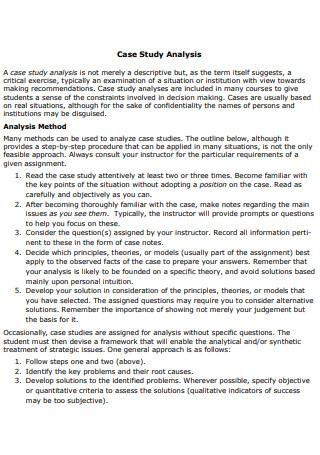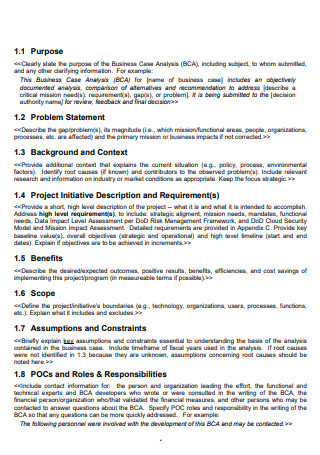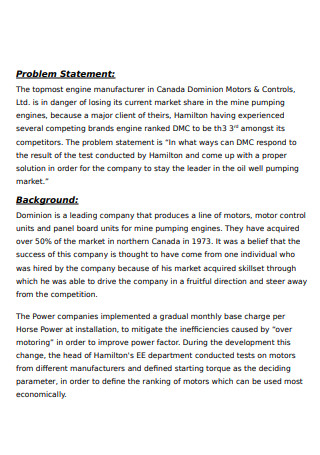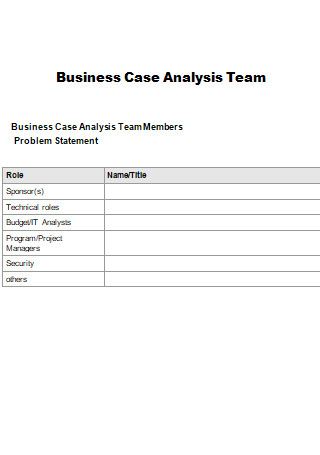3+ SAMPLE Case Analysis Problem Statement
FREE Case Analysis Problem Statement s to Download
3+ SAMPLE Case Analysis Problem Statement
What Is a Case Analysis Problem Statement?
Components of a Case Analysis Problem Statement
How To Write a Case Analysis Problem Statement
FAQs
How do you write a problem statement?
What makes a good problem statement?
What is a problem statement?
The case analysis serves as a way to assess various business decisions before developing ways to execute the final solution. The case analysis allows the organization to figure out the potential internal and external problems, the costs and risks of the problem, and the benefits of particular decisions to take the most appropriate actions. As case analysis deal with business problems, stating and constructing a problem statement is significant. The article provides its readers with sufficient information about a case analysis problem statement, including its definition, components, and a helpful guide to aid individuals in writing a suitable problem statement. A section of the article also deals with answering and addressing frequently asked questions about the statement.
What Is a Case Analysis Problem Statement?
A case analysis problem statement helps state the goal of a business or organization to accomplish a business problem. It also outlines the scope of the project to solve the case analysis of particular business adversity. The case analysis problem statement explains the barrier of the current problem concisely, determining whether it is a functional process or product or a problematic state of affairs within the organization. The problem statement is also very objective, focusing on available factual information rather than subjective opinions from select and varying individuals. To make it easier for the organization to create the structure of the case analysis problem statement, asking the necessary questions to pinpoint the who, what, where, and why of the existing problem. It makes the case analysis problem statement easier to create, allowing readers to comprehend and solve the issue. The problem statement, aside from defining and formulating a solution, helps create a comprehensive proposal that suggests a timely yet effective answer to the problem. It also serves as a guide to performing activities and aid in decision-making procedures with the involved individuals. The statement also helps a business or organization to acquire support in the buy-in process for improvement projects.
According to Forbes, going into the year 2022, many businesses discover various problems in operating and establishing their businesses. As of December 2021, the inflation rate rose to about 7 percent for the first time in decades. Entrepreneurs list it as the most concerning problem they face this year.
Components of a Case Analysis Problem Statement
The problem statement is a brief description of the background and essential individuals for a given scenario, and it provides the context of the problem. It must also detail the possible scenarios and consequences of the problem and a clear statement that convinces the reader of the significance of the problem from the point of view of the company. It must also be able to identify the core problem by identifying the primary issues that comprise the problem. As such, the problem statement must have all the essential information and elements to relay to its readers a clear description of the organizational problem. The section below details the various components that make up the case analysis problem statement and their description for further understanding.
How To Write a Case Analysis Problem Statement
A case analysis problem statement, similar to other problem statements, is a tool that individuals or groups use to gain the support and approval from management and stakeholders to implement possible solutions to solve an organizational problem. As such, the problem statement must be clear, accurate, and comprehensive. There are several things to keep in mind when constructing or developing a problem statement to have a positive impact on the outcome of the proposed project. The section below presents a step-by-step guide to help you write an effective case analysis problem statement.
-
1. Define How Certain Things Should Work
To begin the process of writing the problem statement, the first thing you need to do is to provide background information and context to make it easier for readers to understand the problem. Start by explaining how the entire process should work. Using a concise description of how the process functions if the current problem did not exist before mentioning the specific problem while keeping the end-users in mind. For example, the organization proposes an idea on how to increase the production output by increasing work efficiency by maximizing the best use of resources. You can begin by describing a probable scenario in which the organization develops a more efficient system and work towards the resolution from there. Make sure to keep in mind the who, what, when, where, and why to keep yourself on track.
-
2. State the Problem and Emphasize Why It Matters
The case analysis problem statement must address what the problem is, why the organization considers it a problem, and why it is necessary to find a resolution. It wraps all the other ‘w’ questions that follow, in most cases. For example, why is there a need to fix the problem? The answer to the question must indicate that it affects various departments of the organization, wastes significant resources, and therefore drives prices up for consumers. The statement addresses what the problem is, the affected individuals, and why the problem requires a solution. You must also consider including an overview of the different attempts that the organization implements to solve the problem and the reason why the did not work out in the first place. Explain everything that you know about the problem efficiently and comprehensively.
-
3. Explain the Financial Costs of the Problem
When introducing and explaining the problem to management and stakeholders for decision making, it is also necessary to introduce the associated costs of fixing the problem. Considering that money is the primary language that many businesses and their people speak, it is easy to frame the problem and propose the solution by introducing a solution concerning financial costs. For example, if the problem is actively costing the organization unnecessary money, preventing the business from generating more revenue, or it damages the public image of the company or brand reputation, make sure to specify these factors clearly when explaining the terms for them to have an understanding of the situation. As much as possible, pinpoint the dollar amounts the company losses resulting from the problem.
-
4. Back Up the Claims and Propose a Clear Solution
After claiming that the problem is costing the company money, you must prepare pieces of evidence to support the claims you have. Do not neglect this step of the problem statement. Without it, the decision-makers will have a difficult time taking the problem seriously. Make sure to do your research, cite the necessary resources, and have the presentation of the data all set up. The problem statement must also present and describe a proposed solution to the problem. From this point forward, you must not focus on finding one solution. Instead, you should have a solid grasp of the situation, point out the causes of the problem, and prepare a comprehensive proposal that details practical approaches to understand and remediate the problem. State the objectives by suggesting action plans and remediation plans for solving the problem.
-
5. Highlight the Benefits of the Proposed Solutions
At this step, you already have a clear presentation of the ideal scenario without the existence of the problem. After you properly and accurately identify the problem, explain the ramifications to the company if it is choosing not to address it, and propose several realistic procedures to find a solution, the next step to take is to demonstrate why the solution or solutions work, focusing on its efficiency and effectiveness to mitigate the financial impacts to the organization. Address and pinpoint the expenses the solution decreases, explain that the solution frees up the income streams, and list the intangible benefits it brings, including an increase in client satisfaction, positive customer feedback, and increase in brand recognition. Make sure that all of these fit in a concise yet comprehensive paragraph.
-
6. Conclude the Problem Statement
The next step is to write a comprehensive conclusion. Conclude the case analysis problem statement in a clear summary of the problem and the solution. Make sure that conclusion consists of the initial problem, the reason why it requires resolution, and an argument summary that explains why your solution is the best answer to address the problem. Following the format helps both the parties to read and understand the problem and consider all the possible solutions to arrive at the most efficient and effective answer.
FAQs
How do you write a problem statement?
There are three main steps when writing a problem statement. First, put the problem into context. Second, indicate why discussing the problem matters. Lastly, state the aims and objectives to accomplish the problem.
What makes a good problem statement?
A good problem statement must answer the following questions:
- What is the problem?
- Who has the problem?
- Where and when does the problem happen?
- How often does the problem happen?
- What are the causes?
- What is its impact?
What is a problem statement?
A problem statement is a statement that covers a current issue or problem that needs timely action to improve the present situation.
A case analysis problem statement is necessary to address an urgent and current issue surrounding a business or organization. Developing a clear and concise problem statement that indicates the problem and possible solutions to resolve the problem helps a company to implement the necessary steps for action plans and remediation plans. Make sure that the case analysis problem statement is easy to read and understand to inform the management and stakeholders of the urgency to solve the issue. Create a case analysis problem statement for the next issue that the company encounters by downloading from the 3+ SAMPLE Case Analysis Problem Statement in PDF| MS Word, only from Sample.net.




